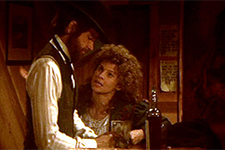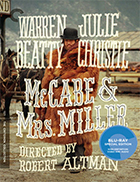McCabe & Mrs. Miller
|  Robert Altman’s McCabe & Mrs. Miller arrived in the midst of a cycle of anti-westerns—preceded by Sam Peckinpah’s The Wild Bunch (1969), Ralph Nelson’s Soldier Blue (1970), and Arthur Penn’s Little Big Man (1970), followed by John Huston’s The Life and Times of Judge Roy Bean (1972), Philip Kaufman’s The Great Northfield Minnesota Raid (1972), and Arthur Penn’s The Missouri Breaks (1976), among others. All of these films, in various ways and to different degrees, undercut the basic tenets of the Western genre, primarily with a newfound sense of moral ambiguity. The basic elements of the genre were still there—the six-shooters, the horses, the frontier towns—but the genre’s underlying thematic tropes—the righteousness of the gunslinger, the power balance between men and women, the justification of war waged against Native Americans, the hope of truly carving civilization out of the wilderness—were made dubious. However, there had been none quite like McCabe & Mrs. Miller, which shouldn’t be surprising given Altman’s utterly unique ability to take any story, any topic, any genre, no matter how familiar, and put it through his own artistic wringer and come out with something that felt fresh, challenging, and wholly original. In fact, if I had to name the film most reflective of the New Hollywood of the 1970s, it would have to be this one. McCabe & Mrs. Miller was made at a time when the Hollywood industry, which had seemed virtually unshakeable a few decades earlier, was floundering amid cultural, demographic, and political change, unsure of who their audience was and how to appeal to them. The result was the takeover of almost every major studio by a multinational conglomerate, the erosion of the old guard in favor of younger producers and executives, and an influx of film-school trained talent behind the camera who would go on to produce a decade’s worth of new classics that borrowed liberally from the Golden Era of Hollywood, but were infused with aesthetics and ideology from various European new waves and a new license in depicting violence and sexuality. McCabe & Mrs. Miller embodies almost every characteristic of the New Hollywood, sometimes to an almost absurd degree: it is a revisionist genre film featuring a complex protagonist who could easily be dismissed as a “loser”; it undercuts star power by casting said “loser” with a popular, handsome marquee idol; it upends conventional sexism by giving most of the narrative’s power to not just a woman, but a prostitute; it is shot in the hazy, low-contrast style that was coming into favor at the time; and it emphasizes realism in the gritty, frigid location work while employing self-conscious stylistic devices like zooms, slow motion, and an overlay of bittersweet ballads by folk singer Leonard Cohen. Despite sharing thematic and aesthetic proclivities with young, film-school trained directors like Francis Ford Coppola and Martin Scorsese, Altman was not technically one of them; rather, he had been a prolific television director since the early 1950s who moved into feature film directing in the 1960s, scoring a major commercial and critical hit with M*A*S*H (1970), a war satire that remains one of the most subversive comedies to escape a major studio. It is easy to imagine that, had M*A*S*H not been a commercial success and not spun off one of the decade’s most popular television series, his career in feature films might have ended there. But, it didn’t—and we are all the richer for it. Following his oddball fantasy Brewster McCloud (1970), Altman turned his attention to McCabe & Mrs. Miller, which was based on the novel McCabe by Edmund Naughton. Set almost entirely in Presbyterian Church, a tiny, but growing mining settlement in the Pacific Northwest, the story centers on the relationship between John McCabe (Warren Beatty), a (possibly) former gunslinger-turned-professional gambler and businessman, and Constance Miller (Julie Christie), a madam who convinces him to build and allow her to manage an elaborate whorehouse. Like many a Western before it, McCabe & Mrs. Miller opens with McCabe, a mysterious figure buried in a massive bearskin coat, riding into town from the wilderness. He starts up a poker game at the only saloon in town, a dank, miserable place, and everyone is immediately awash in speculation about who he is. While McCabe’s background remains hazy, his intentions come quickly into focus, as he sets about building his own saloon as the town’s centerpiece. When Mrs. Miller arrives in town, specifically to see him, she convinces him to alter his plans and turn it into a fully functional, high-price whorehouse (his idea had been to bring in some prostitutes from a neighboring town and set them up in small tents outside the saloon). The whorehouse becomes a kind of beacon in the wilderness, promising men not just sexual gratification, but silk sheets, warm baths, and fine food. It is, in its way, a bit of civilization standing out from the mud and grit of the wilderness that surrounds it. The business venture is a success, and McCabe, emboldened by his new prominence and financial power, dismisses the attempts by a large mining company to buy him out. Blinded into believing that he is more than just a big fish in a small pond, he is unable to recognize the danger posed by real sharks, and once he sees the light and tries to renegotiate, it is too late. The opportunity to play nice has passed, leaving only violence, which, having been largely absent from the first two-thirds of the film, hangs heavily over its third act, initiated by the brutal and callous killing of one character by a representative of the mining company, thus ensuring our fears that they are willing to do whatever it takes to get what they want. Woven throughout the narrative is McCabe’s growing romantic attachment to Mrs. Miller, which brings up feelings that he is not quite able to manage and that she, being a professional in the art of making men feel important and powerful, isn’t in a position to reciprocate. Of course, to some extent (at least, if Altman is to be believed), the story in McCabe & Mrs. Miller is, if not entirely irrelevant, at least subservient to the atmosphere. Altman put most of his artistic energy into creating a mood, a sense of time and place that the story essentially justifies. There were movies at the time that shared some aesthetic similarities to McCabe & Mrs. Miller, but none that employed so many extremes to create an almost dreamlike vision of the frontier at the turn of the century (the setting in the Pacific Northwest, with its towering evergreens, made for a nice visual change of pace while also maintaining historical accuracy). Altman worked with production designer Leon Erickson to create a world of largely muted colors so that the film would resemble the daguerreotypes of the late 19th century, and he and cinematographer Vilmos Zsigmond took the risk of “flashing” the film (meaning exposing the otherwise unexposed negative to light) to further wash out the image, lowering contrast and graying out the blacks. Combined with the visual textures of the setting itself (which tend to be either rain-drenched and muddy or snow-covered), Altman’s visual approach results in a film that looks like something new by reproducing the look of something old. At the time, there were complaints about Altman’s approach to dialogue, which involves characters talking over each other and often mumbling in a way that makes hearing every word impossible. Altman’s intention was to create a more realistic milieu, one in which you catch parts of conversations, but never the whole (Orson Welles had done something similar in Citizen Kane, but Altman took it much, much further). While it is easy to see why this might create some frustration, it creates a sense of presence that is often belied by the neat and clean sound design we are used to in Hollywood productions. It was another way that Altman could undercut the expected while achieving something that is more palpable and realistic. The same could be said for the performances, especially Warren Beatty as McCabe. Having already reached superstar status in the New Hollywood with the groundbreaking Bonnie and Clyde (1967), Beatty continued to buck tradition by using his matinee good looks in the service of playing antiheroes. McCabe is one of his greatest creations—a man who talks big, but often at the wrong time; who sees himself as much more than he is, and once aware of that fact, is downright pathetic in trying to backtrack; who mumbles to himself in a way that suggests his confidence is just bluster. We can’t help but like him, which is what gives the film, despite its esoteric artistic design and elliptical nature, a real hook. For all its improvisation and daring, McCabe & Mrs. Miller is a moving portrait of how the little man, no matter how confident in himself, is usually at the mercy of others with more money and more power and less scruples. That is, like all Westerns, it is a microcosm of the story of America.
Copyright © 2016 James Kendrick Thoughts? E-mail James Kendrick All images copyright © The Criterion Collection and Warner Bros. | |||||||||||||||||||||||||||||||||||
Overall Rating: 


 (4)
(4)


